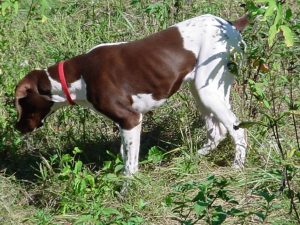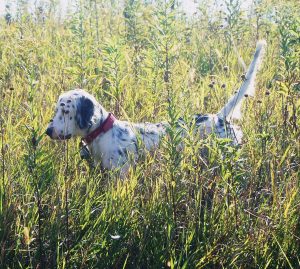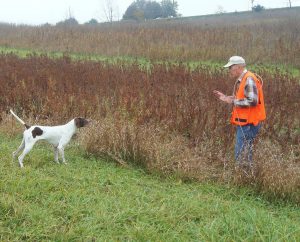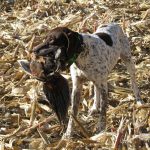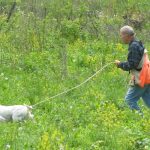Back to Basics: Blinking
POINTING DOG POINTERS
By Bob and Jody Iler
Before you can get back to the basics when addressing the problem of “blinking”—first you’ll want to know just what blinking is!
When you take your dog to the field, the dog that is blinking will begin to hunt and work the field and then, when he gets bird scent, will avoid the bird or detour around it. Since you’ve planted the bird(s), you’ll come to recognize that though the dog knows it’s there, he is avoiding it (blinking). Sometimes the dog will go on point briefly, then act as though the bird has run off, and pretend he’s hunting again.
Blinking is a problem that may not be immediately recognized by the novice pointing dog owner. It can be pinpointed more readily when you work your dog on planted birds, because you know the birds are out there and you know approximately where you’ve planted those birds. Your dog may avoid the birds in such a discreet manner that you really aren’t sure.
Obviously, blinking can be more difficult to detect when you’re hunting your dog on wild birds as you’ve no way of knowing for sure: 1) if birds are even there and 2) whether he’s actually scented a bird and avoided it. You might notice flash points and half-hearted relocating, but might not connect the dots that your dog is actually avoiding the birds once he scents them.
Poor scenting conditions could also seem to mimic blinking in some situations. When weather conditions are extreme, your dog may have trouble with scenting the birds and may seem as though he is trying to avoid them when he’s really trying to find them. If you think your dog might be blinking birds, It’s crucial to study the problem carefully for concrete clues as to why this might be the problem and how it came about.
So what causes blinking?
The answer is very simple and yet a number of different things can cause it. Even if you’ve brought your dog along successfully in her training and she’s doing well, a potentially bad experience with birds can lead to blinking. Working young dogs on loud, cackling rooster pheasants can prove unpleasant to some soft dogs. Birds that flush and fly fast and loud can scare youngsters just getting their feet wet. Getting spurred by a wounded rooster can lead a dog to start blinking birds. Overly zealous force-fetch training with young dogs can really turn them off of birds. For example, forcing a large bird into a pup’s mouth and holding his jaws tightly over it while insisting he hold it can do great harm to young dogs that are not yet bird crazy. In short, anything unpleasant associated with a bird can cause a dog to start blinking.
Putting too much pressure on young dogs in their early training can cause blinking. Trying to make young dogs stay steady to wing and shot before they are really ready can create unpleasant associations with birds and training. “College level” training requires more intense methods that young dogs should not be subjected to. In short, anything unpleasant associated with your training and birds can cause your dog to start blinking.
Over the years we’ve had several dogs come to the kennel with their owners describing their problem as “not hunting.” We would take these young dogs out on planted birds and see immediately that once they got bird scent, they were avoiding the birds. After talking with their owners, we would generally find out that something unpleasant had occurred in their early training and/or bird work which had caused them to quit pointing or lose interest in birds and hunting.
The blinking problem can usually be successfully solved, but not without plenty of time and going back to the basics. The dog’s owner has to make a commitment to not worrying about the dog’s gun development, advanced training, or retrieving skills at this point.
The blinking dog needs to go back to her puppy days, when there were no rules, just fun. Assuming that back then, she did love the birds at the start, we pretend this dog is a pup and reintroduce her to birds on her terms, by starting “small.” We’ll use quail because their size and gamey scent gives wary dogs encouragement and enthusiasm. If she likes an introduction to one lively quail, we let her chase. Then we’ll expand to a couple quail out in the field that she can find and chase. There will be no gunfire, no checkcord work, no demands to pick up the bird and retrieve, no pressure whatsoever—just birds and fun.
This process doesn’t take place within a week. We watch the dog’s progress carefully, sticking with one chased bird at first, then quitting. After a week of this, we’ll add another bird. We’ll encourage the dog to chase. We want to build enthusiasm and drive, and this will take time—time to learn to love birds again and make new, exciting associations with them to blot out the unpleasant ones. Every lesson should be short, fun and end on a positive note.
When your dog begins pointing birds again, always flush the bird by swinging wide around the dog and approach the bird facing the dog. Never come up from behind the dog. This can cause him to worry about you and take his mind off the bird. Don’t force your dog to stay steady at the flush either. You want his mind focused on one thing only: the bird and his enthusiasm for it.
Learn to read your dog and watch for the signs that he’s ready for you to try a different larger bird, such as a pigeon or chukar. Keep in mind that these birds flush quickly and fly up and away, so if his motivation is not where it needs to be, the flight of the bird can diminish his interest and focus. If this happens, go back to quail, which often flush and come back down nearby, offering more opportunities to maintain the dog’s enthusiasm. Take your time and make sure your dog has become bird crazy and regained his drive before you worry about pheasants. And when you think he’s ready, start with hens (since they don’t have spurs), and then later on, roosters. All will come in good time.
Once you are confident that your dog is ready, you can start to gradually reintroduce the gun work (if your dog was developed to the gun before). Don’t overwhelm him; stick with bird work and gentle gun progression only. If he’s a natural retriever and has fun picking up the bird and bringing it back, that’s great, but don’t make any demands at this stage. And don’t try to force break or steady the dog that was blinking, now that you’ve got him well on his way. Wait until you’ve had a couple of good seasons of hunting with your dog before you attempt other training. None of the advanced stuff will do you any good if you don’t have a bird dog, first and foremost!
There’s no magic cure for blinking or many of the other problems that surface in the development of our bird dogs. Time, patience and understanding will work wonders—and most of all—going back to the basics!
Pointing Dog Pointers features monthly training tips by Bob and Jody Iler, who own Green Valley Kennels in Dubuque, Iowa. Bob and Jody have trained pointing dogs for over 35 years and have written many articles for The Pointing Dog Journal.



